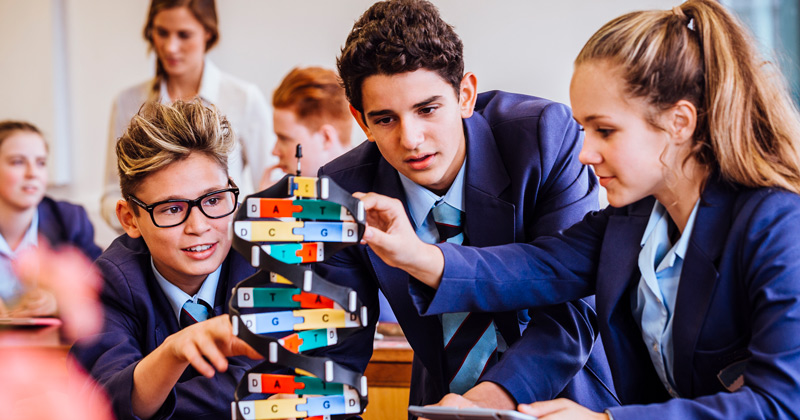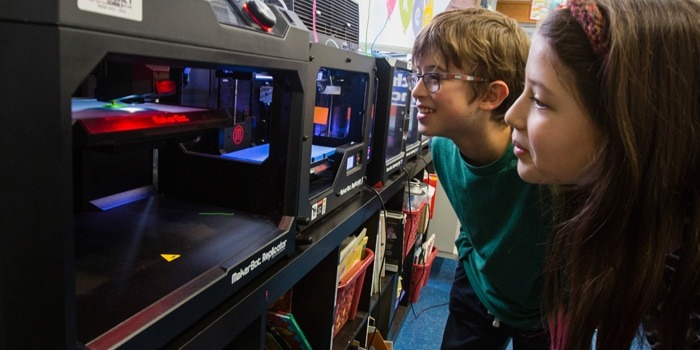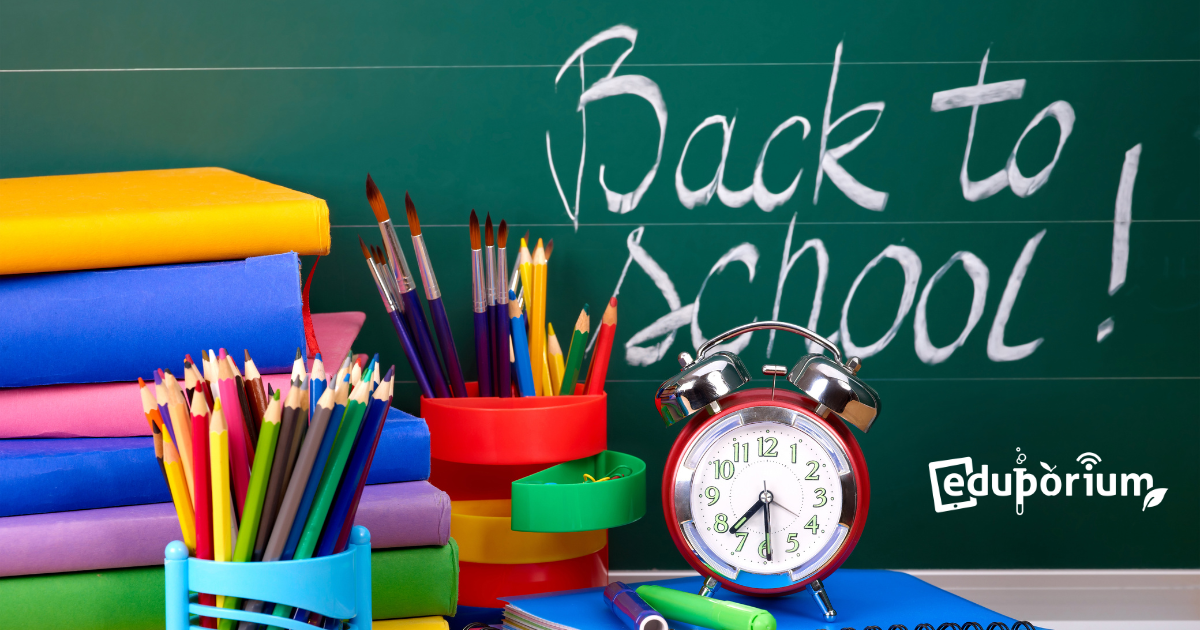Ready for summer vacation yet? If you are not as excited about getting back to school as you should be, just remember there are some pretty awesome ways to make it better! Here are some examples, including incorporating blended learning, innovating the classroom and starting collaboration.
Blended Learning is Better Learning
Who can say something that gets better when it is blended with something else? One student shouts out “Music!” Another offers up “Milkshakes!” Look at that, you’re collaborating already. Music and milkshakes, however wonderful they each might be, aren't the only things that are great when paired with other things. Blended learning is currently carving its path into mainstream education with as much force as Hurricane Fred. Okay, maybe not quite as much, but it’s still equally powerful. That's because when it comes to good learning in the 21st century, two minds are often better than one.
Like enhancing any aspect of education, there are effective ways to implement new systems and there are some to avoid. Lucky for you, we have a good list. One secret to success might just begin at the source. If staff members aren’t ready to start something new, how can they expect the students to adjust properly? It might take time, but training instructors to teach properly is equally important as them teaching new things. Coupling that expertise, however, must be this appropriate balance of leeway. They need to know it is okay to fail (because failing is just the First Attempt In Learning). Teachers might think they have a great idea and then realize that it’s doing nothing for kids or they'll need added practice or increased improvement. That’s okay! You still learned—and the students did too.
Once you iron out kinks and you really feel out how blended learning blends with your brain, it should take off. Knowing what resources and technologies are accessible to children at home is important for deciding what to do next. Also consider the goals and objectives—are they realistic for you and your students? And, what technologies could help engage those students along the way? Trust us, once you start out, you'll all recognize the significance of learning by doing almost immediately. And, even for those super experienced educators, there isn't much that can replace that experience. Keep these tips in mind and you’ll be well on your way to blending an innovative classroom this school year.
Classrooms Evolving Into Learning Spaces
What part about sitting in a row of uncomfortable desks for seven some-odd hours a day seems exciting? The part when you finally get up to leave? Unfortunately, the above description summarizes the education experience for far too many of today’s students, but thankfully educators are now truly realizing the power and importance of breaking away from traditional methods of learning and delving deeper into interactive, project-based experiences that will really allow the concepts—not just names and numbers—to stick with students. If we had our way, every classroom would include technology and sound a lot like this.
One of the first things to go, in fact, might be the word “classroom.” There have always been “classrooms.” What do “classrooms” include? Desks, chairs, chalkboards, disengaged kids, and one person talking—the teacher. In the 21st century, couldn’t classrooms improve a little bit—not just physically but descriptively as well? Learning spaces promote a sense of community, collaboration, interactivity, and growth by getting all children physically involved with lessons either through dialogue or active, project-based learning. Learning equipment is up-to-date, desks are now comfortable tables or benches, and students are doing a lot more talking. All of these things make for a much-improved experience.
This is the kind of environment in which kids could learn to take risks and learn from one another—not just around one another. Experimentation and adventure will teach children more than a textbook because they can truly apply it in the real world. With so much of today’s technology ready for the mobile world and also without wearing holes in their seats, kids learn much better when they can truly explore all that is going on around them. They learn STEM skills that they'll use every day of their lives and become true 21st century citizens. The days of neatly aligned rows can and should be numbered. Makerspaces are their classrooms of the future as they offer the best option for a true learning space. No restrictions means it's a truly open education and technologies offer an environment with no real restrictions.

Collaboration Nation
There are a number of ways that student collaboration can enhance learning and help kids bolster those 21st century skills they will need in the real world. They can engage in experiments, extended projects and even at-home assignments by utilizing modern EdTech products and services. And, if kids can do it, so too can teachers and—guess what—they really should be. Collaboration can help spark new ideas or help you solve that dilemma you’ve been working on since Winter Vacation. If one teacher knows an innovative and proven teaching method, shouldn’t they all be using it? That’s what collaboration is for!
Of course, you could set up meetings that last for hours after school, but if you are a teacher, you probably don’t have half enough time for that. That is where tech comes in. Modern tools make it so much easier for teachers (any anyone else) to collaborate because they don’t all have to be in the same room—or the same building or the same state. You get the picture. Establishing a common drive to share your work, ideas, and progress (even on something as simple as Google Docs) is a perfect way for any teachers to keep in touch. They could base their work around who they feel working with benefits them most and foster solutions that resolve conflicts. What did they tell you in kindergarten? Talk it out. Collaboration works in the same way.
Even without meeting in person, educators who collaborate electronically can access each other’s lessons and resources, which, of course, can get the wheels turning for coming up with add-ons to these materials. This also ensures there's little or no overlap among educators who could be teaching the same students in multiple classes. If possible, principals can play a role as well by making sure that everyone is able to find a time to meet in person to discuss ideas and results. Getting everybody together at the same times and in the same place is no easy task, but, hey, there isn’t much about being a principal that is easy. If necessary, principals can arrange for substitute teachers on certain days so that their faculty can improve as much as possible. How do you ensure that your school strives to become a collaboration nation?
What to Consider When Buying a 3D Printer
For innovative teachers and inquisitive students, discovering the latest and greatest classroom technology is one process that never really ends. One good place to take a pit stop, however, is over in the land of 3D printers. With 3D printers, kids could dream up, design, and print their own innovative creations right from their desk and most importantly, the learning potential is definitely sky high! Crafting decorations, tools, or masterpieces is fun and easier when you’ve selected the perfect printer for your needs and expertise.
There are a few key factors to consider when trying to choose the 3D printer that will benefit both teachers and students as much as possible. Educators should be familiar with where to look and with which printers have the most useful features. Printers from Afinia, MakerGear, 3D Systems, and, of course, MakerBot tend to work great in classroom environments. (And, they’re even better when you can buy them from us!) When doing your research about which brands to go with, pay attention to the reviews—a lot of them actually are helpful—and keep your eye out for these industry-leading brand names.
Now for the features; what do you want to accomplish that a 3D printer could help with? Customarily, when searching, there are three considerations: reliability, ease of use, and technology. To eliminate as many tech glitches as possible, spending up on something that's proven is usually worth doing. Advice from any other educators who've been there can also be valuable. The next consideration is ease of use. Chances are you haven't had much experience with 3D printing, so something easier is essential when starting out. Different printers need to be set on different settings to work optimally, so consider this, too. Finally, make sure your printer is at least somewhat up-to-date technology wise. Even in their short history, 3D printers are capable of more and more so you might as well get one that can do a lot. They can even start becoming obsolete in as little as two years.

Tackling the New School Year...As Best You Can
There’s nothing enticing about getting back in the classroom when the thermometer still says 90 degrees. Luckily, there are ways to cope with not being able to sit by your pool with your feet up and a magazine in your hand all day long. After an entire summer, re-energizing, planning, and organizing should all be taken care of and all you should be waiting for is the first bell to ring. Just in case you’re stuck in summer mode, however, here are some tips to help you through the annual adjustment with as little shock as possible.
Thankfully, educational technology tools have come a long way even if other things have not. One of the best ways to get organized is putting all pertinent information in one place. Grades, lessons, classes—they can all be organized neatly with a little patience and planning. There are even digital platforms designed for just this reason! Why did it take so long to come up with that concept? It helps educators track every move students make throughout the year, generate necessary reports, and share results much more simply.
Also, try not to feel overwhelmed once the realization of being back inside the classroom comes screaming (perhaps literally) back at you. It’s important to remember, especially if you are starting a new year teaching with technology, that you don’t have to be completely proficient right away. Gradual progress and learning from mistakes are fine! Now that you are back though, doesn’t it seem like the best way to prepare for the new school year would have been to not do a single thing the entire summer? Good luck!
Follow us on Twitter for more.



